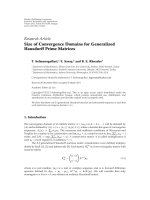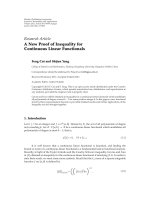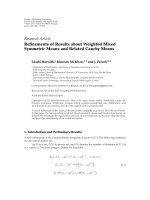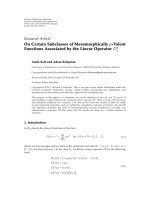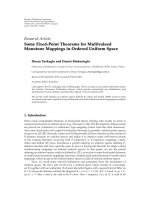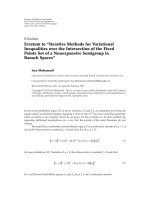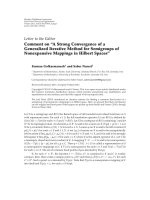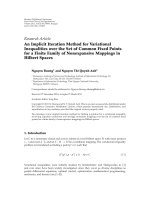Hindawi Publishing Corporation Advances in Difference Equations Volume 2011, Article ID 234215, 12 docx
Bạn đang xem bản rút gọn của tài liệu. Xem và tải ngay bản đầy đủ của tài liệu tại đây (504.92 KB, 12 trang )
Hindawi Publishing Corporation
Advances in Difference Equations
Volume 2011, Article ID 234215, 12 pages
doi:10.1155/2011/234215
Research Article
Value Distributions and Uniqueness of
Difference Polynomials
Kai Liu, Xinling Liu, and TingBin C ao
Department of Mathematics, Nanchang University, Nanchang, Jiangxi 330031, China
Correspondence should be addressed to Kai Liu,
Received 21 January 2011; Accepted 7 March 2011
Academic Editor: Ethiraju Thandapani
Copyright q 2011 Kai Liu et al. This is an open access article distributed under the Creative
Commons Attribution License, which permits unrestricted use, distribution, and reproduction in
any medium, provided the original work is properly cited.
We investigate the zeros distributions of difference polynomials of meromorphic functions, which
can be viewed as the Hayman conjecture as introduced by Hayman 1967 for difference. And we
also study the uniqueness of difference polynomials of meromorphic functions sharing a common
value, and o btain uniqueness theorems for difference.
1. Introduction
A meromorphic function means meromorphic in the whole complex plane. Given a meromor-
phic function f,recallthatα
/
≡ 0, ∞ is a small function with respect to f,ifTr, αSr, f,
where Sr, f is used to denote any quantity satisfying Sr, foTr, f,asr →∞
outside a possible exceptional set of finite logarithmic measure. We use notations ρf,
λ1/f to denote the order of gr owth of f and the exponent of convergence of the poles
of f, respectively. We say that meromorphic functions f and g share a finite value a IM
ignoring multiplicities when f − a and g − a have the same zeros. If f − a and g − a have
the same zeros with the same multiplicities, then we say that f and g share the value a CM
counting multiplicities. We assume that the reader is familiar with standard notations and
fundamental results of Nevanlinna Theory 1–3
.
As we all know that a finite value a is called the Picard exception value of f,iff − a
has no zeros. The Picard theorem shows that a transcendental entire function has at most
one Picard exception value, a transcendental meromorphic function has at most two Picard
exception values. The Hayman conjecture 4,isthatiff is a transcendental meromorphic
function and n ∈
,thenf
n
f
takes every finite nonzero value infinitely often. This conjecture
has been solved by Hayman 5 for n ≥ 3, by Mues 6 for n 2, by Bergweiler and Eremenko
7 for n 1. From above, it is showed that the Picard exception value of f
n
f
may only
2AdvancesinDifference Equations
be zero. Recently, for an analog of Hayman conjecture for difference, Laine and Yang 8,
Theorem 2 proved the following.
Theorem A. Let f be a transcendental entire function with finite order and c be a nonzero complex
constant. Then for n ≥ 2, fz
n
fz c assumes every nonzero value a ∈ infinitely often.
Remark 1.1. Theorem A implies that the Picard exception value of fz
n
fz c cannot be
nonzero constant. However, Theorem A does not remain valid for meromorphic functions.
For example, fze
z
− 1/e
z
1, n 2, 3, c iπ. Thus, we get that fz
2
fz c
e
z
− 1/e
z
1 never takes the value −1, and fz
3
fz ce
z
− 1/e
z
1
2
never takes
the value 1.
As the improvement of Theorem A to the case of meromorphic functions, we first
obtain the following theorem. In the following, we assume that αz and βz are small
functions with respect of f, unless otherwise specified.
Theorem 1.2. Let f be a transcendental meromorphic function with finite order and c be a nonzero
complex constant. If n ≥ 6, then the difference polynomial fz
n
fz c − αz has infinitely many
zeros.
Remark 1.3. The restriction of finite order in Theorem 1.2 cannot be d eleted. This can be seen
by taking fz1/Pze
e
z
, e
c
−n n ≥ 6, Pz is a nonconstant polynomial, and Rz is a
nonzero rational function. Then fz is of infinite order and has finitely many poles, while
f
z
n
f
z c
− R
z
1 − P
z
n
P
z c
R
z
P
z
n
P
z c
1.1
has finitely many zeros. We have given the example when n 2, 3inRemark 1.1 to show that
fz
n
fz c − αz may have finitely many zeros. But we have not succeed in reducing the
condition n ≥ 6ton ≥ 4inTheorem 1.2.
In the following, we will consider the zeros of other difference polynomials. Using the
similar method of the proof of Theorem 1.2 below, we also can obtain the following results.
Theorem 1.4. Let f be a transcendental meromorphic function with finite order and c be a nonzero
complex constant. If n ≥ 7, then the difference polynomial fz
n
fzc− fz−αz has infinitely
many zeros.
Theorem 1.5. Let f be a transcendental meromorphic function with finite order and c be a nonzero
complex constant. If n ≥ 6, m, n ∈
, then the difference polynomial fz
n
fz
m
− afz c − αz
has infinitely many zeros.
Remark 1.6. The above two theorems also are not true when f is of infinite order, which can
be seen by function fze
e
z
/z, e
c
−n,whereαz1/z
n
z c in Theorem 1.4 and
αz−a/z
n
z c in Theorem 1.5.
Theorem 1.7. Let f be a transcendental meromorphic function with finite order and c be a
nonzero complex constant. If n ≥ 4m 4, m, n ∈
, then the difference polynomial fz
n
βzfz c − fz
m
− αz has infinitely many zeros.
Advances in Difference Equations 3
Corollary 1.8. There is no transcendental finite order meromorphic solution of the nonlinear differ-
ence equation
f
z
n
H
z
f
z c
− f
z
m
R
z
, 1.2
where n ≥ 4m 4 and Hz, Rz are rational functions.
Remark 1.9. Some results about the zeros distributions of difference polynomials of entire
functions or meromorphic functions with the condition λ1/f <ρf can be found in 9–
12. Theorem 1.7 is a partial improvement of 11,Theorem1.1 for f is an entire function and
is also an improvement of 13,Theorem1.1 for the case of m 1.
The uniqueness problem of differential polynomials of meromorphic functions has
been considered by many authors, such as Fang and Hua 14, Qiu and Fang 15,Xuand
Yi 16,YangandHua17, and Lahiri and Rupa 18. The uniqueness results for difference
polynomials of entire functions was considered in a recent paper 15, which can be stated as
follows.
Theorem B
see 19,Theorem1.1. Let f and g be transcendental entire functions with finite
order, and c be a nonzero complex constant. If n ≥ 6, fz
n
fz c and gz
n
gz c share z CM,
then f t
1
g for a constant t
1
that satisfies t
n1
1
1.
Theorem C see 19,Theorem1.2. Let f and g be transcendental entire functions with finite
order, and c be a nonzero complex constant. If n ≥ 6, fz
n
fz c and gz
n
gz c share 1 CM,
then fg t
2
or f t
3
g for some constants t
2
and t
3
that satisfy t
n1
2
1 and t
n1
3
1.
In this paper, we improve Theorems B and C to meromorphic functions and obtain t he
following results.
Theorem 1.10. Let f and g be transcendental meromorphic functions with finite order. Suppose that
c is a nonzero constant and n ∈
.Ifn ≥ 14, fz
n
fz c and gz
n
gz c share 1 CM, then
f tg or fg t,wheret
n1
1.
Theorem 1.11. Under the conditions of Theorem 1.10,ifn ≥ 26, fz
n
fz c and gz
n
gz c
share 1 IM, then f tg or fg t,wheret
n1
1.
Remark 1.12. Let fze
z
− 1/e
z
1 and gze
z
1/e
z
− 1, c iπ.Thus,fz
n
fz
ce
z
− 1/e
z
1
n−1
and gz
n
gz ce
z
1/e
z
− 1
n−1
sharethevalue1CM.
From above, the case fg t,wheret
n1
1 may occur in Theorems 1.10 and 1.11.
From the proof of Theorem 1.11 and 2.7 below, we obtain easily the next result.
Corollary 1.13. Let f and g be transcendental entire functions with finite order, and c be a nonzero
complex constant. If n ≥ 12, fz
n
fz c and gz
n
gz c share 1 IM, then f tg or fg t,
where t
n1
1.
2. Some Lemmas
The difference logarithmic derivative lemma of functions with finite order, given by Chiang
and Feng 20, Corollary 2.5, Halburd and Korhonen 21,Theorem2.1, plays an important
part in considering the difference Nevanlinna theory. Here, we state the following version.
4AdvancesinDifference Equations
Lemma 2.1 see 22,Theorem5.6. Let f be a transcendental meromorphic function of finite order,
and let c ∈
.Then
m
r,
f
z c
f
z
S
r, f
, 2.1
for all r outside of a set of finite logarithmic measure.
Lemma 2.2 see 20,Theorem2.1. Let fz be a transcendental meromorphic function of finite
order. Then,
T
r, f
z c
T
r, f
S
r, f
. 2.2
For the proof of Theorem 1.4, we need the following lemma.
Lemma 2.3. Let fz be a transcendental meromorphic function of finite order. Then,
T
r, f
z
n
f
z c
− f
z
≥
n − 1
T
r, f
S
r, f
. 2.3
Proof. Assume that Gzfz
n
fz c − fz,then
1
fz
n1
1
G
f
z c
− f
z
f
z
. 2.4
Using the first and second main theorems of Nevanlinna theory and Lemma 2.1,weget
n 1
T
r, f
≤ T
r, G
z
T
r,
f
z c
− f
z
f
z
O
1
≤ T
r, G
z
m
r,
f
z c
− f
z
f
z
N
r,
f
z c
− f
z
f
z
O
1
≤ T
r, G
z
N
r,
f
z c
f
z
S
r, f
≤ T
r, G
z
2T
r, f
S
r, f
,
2.5
thus, we get the 2.3.
In order to prove Theorem 1.5 and Corollary 1.13, we also need the next result.
Lemma 2.4. Let fz be a transcendental meromorphic function with finite order, F fz
n
fz
m
−
afz c.Then
T
r, F
≥
n m − 1
T
r, f
S
r, f
. 2.6
Advances in Difference Equations 5
If f is a transcendental entire function with finite order, and m 0, a
/
1,then
T
r, f
z
n
f
z c
n 1
T
r, f
S
r, f
. 2.7
Proof. We deduce from Lemma 2.1 and the standard Valir on-Mohon’ko 23 theorem,
n m 1
T
r, f
T
r, f
n1
f
m
− a
≤ m
r, f
n1
f
m
− a
N
r, f
n1
f
m
− a
≤ m
r, F
z
f
z
f
z c
N
r, F
z
f
z
f
z c
≤ T
r, F
m
r,
f
z
f
z c
N
r,
f
z
f
z c
S
r, f
≤ T
r, F
2T
r, f
S
r, f
.
2.8
Thus, 2.6 follows from 2.8.Iff is entire and m 0, a
/
1, then from above, we get
T
r, f
z
n
f
z c
≥
n 1
T
r, f
S
r, f
. 2.9
Moreover, Tr, fz
n
fz c ≤ n 1Tr, fSr, f follows by Lemma 2.2.Thus2.7 is
proved.
Lemma 2.5 see 17, Lemma 3. Let F and G be two nonconstant meromorphic functions. If F and
G share 1 CM, then one of the following three cases holds:
i max{Tr, F,Tr, G}≤N
2
r, 1/FN
2
r, FN
2
r, 1/GN
2
r, GSr, F
Sr, G,
ii F G,
iii F · G 1,
where N
2
r, 1/F denotes the counting function of zeros of F such that simple zeros are counted once
and multiple zeros are counted twice.
For the proof of Theorem 1.11, we need the following lemma.
Lemma 2.6 see 16, Lemma 2.3. Let F and G be two nonconstant meromorphic functions, and
F and G share 1 IM. Let
H
F
F
− 2
F
F − 1
−
G
G
2
G
G − 1
. 2.10
6AdvancesinDifference Equations
If H
/
≡ 0,then
T
r, F
T
r, G
≤ 2
N
2
r,
1
F
N
2
r, F
N
2
r,
1
G
N
2
r, G
3
N
r, F
N
r, G
N
r,
1
F
N
r,
1
G
S
r, F
S
r, G
.
2.11
3. Proof of the Theorems
Proof of Theorem 1.2. Since f is a transcendental meromorphic function, assume that Gz
fz
n
fz c − αz,thenwecanget
T
r, G
z
≥ T
r, f
z
n
f
z c
S
r, f
≥ T
r, f
z
n
− T
r, f
z c
S
r, f
≥
n − 1
T
r, f
z
S
r, f
.
3.1
Using the second main theorem, we have
n − 1
T
r, f
≤ T
r, G
S
r, f
≤
N
r, G
N
r,
1
G
N
r,
1
G α
z
S
r, G
≤
N
r, f
N
r, f
z c
N
r,
1
f
N
r,
1
f
z c
N
r,
1
G
S
r, f
≤ 4T
r, f
N
r,
1
G
S
r, f
.
3.2
So the condition n ≥ 6 implies that G must have infinitely many zeros.
Proof of Theorem 1.7. Let
ψ :
β
z
f
z c
− f
z
m
− α
z
f
z
n
. 3.3
We proceed to prove that ψ 1 has infinitely many zeros, which implies that fz
n
βzfz c − fz
m
− αz has infinitely many zeros. We first prove that
T
r, ψ
≥
n − 2m
T
r, f
S
r, f
. 3.4
Advances in Difference Equations 7
Applying the first main theorem and Lemma 2.2, we observe that
T
r, f
z
n
T
r, ψ ·
1
β
z
f
z c
− f
z
m
− R
z
O
1
≤ T
r, ψ
T
r, β
z
f
z c
− f
z
m
− α
z
O
1
≤ T
r, ψ
2mT
r, f
S
r, f
.
3.5
From 3.5, we easily obtain the inequality 3.4. Concerning the zeros and poles of ψ,we
have
N
r, ψ
≤ N
r, f
z c
N
r,
1
f
S
r, f
≤ 2T
r, f
S
r, f
,
3.6
N
r,
1
ψ
≤
N
r, f
N
r,
1
f
z c
− f
z
m
− α
z
/β
z
S
r, f
≤ T
r, f
2mT
r, f
S
r, f
.
3.7
Using the second main theorem, Lemma 2.2, 3.6 and 3.7,weget
n − 2m
T
r, f
≤ T
r, ψ
S
r, f
≤
N
r, ψ
N
r,
1
ψ
N
r,
1
ψ 1
S
r, f
≤
3 2m
T
r, f
N
r,
1
ψ 1
S
r, f
.
3.8
Since n ≥ 4m 4, then 3.8 implies that ψ 1 has infinitely many zeros, completing the
proof.
Remark 3.1. It is easy to know that if αz ≡ 0, then 3.7 can be replaced by
N
r,
1
ψ
≤ 3T
r, f
S
r, f
, 3.9
which implies that n ≥ 2m 6inTheorem 1.7.
Proof of Theorem 1.10. Let Fzfz
n
fz c and Gzgz
n
gz c.Thus,F and G share
the value 1 CM. Suppose first that F
/
G and F · G
/
1. From the beginning of the proof of
Theorem 1.2,weobtain
T
r, F
≥
n − 1
T
r, f
S
r, f
,
T
r, G
≥
n − 1
T
r, g
S
r, g
.
3.10
8AdvancesinDifference Equations
Moreover, from Lemma 2.2,itiseasytoget
T
r, G
≤
n 1
T
r, g
S
r, g
,
T
r, F
≤
n 1
T
r, f
S
r, f
.
3.11
Using the second main theorem, we have
T
r, F
≤
N
r, F
N
r,
1
F
N
r,
1
F − 1
S
r, F
≤
N
r, f
N
r, f
z c
N
r,
1
f
N
r,
1
f
z c
N
r,
1
G − 1
S
r, f
≤ 4T
r, f
T
r, G
S
r, f
≤ 4T
r, f
n 1
T
r, g
S
r, g
S
r, f
.
3.12
Thus,
n − 5
T
r, f
≤
n 1
T
r, g
S
r, g
S
r, f
. 3.13
Similarly, we obtain
n − 5
T
r, g
≤
n 1
T
r, f
S
r, g
S
r, f
. 3.14
Therefore, from 3.13 and 3.14, Sr, fSr, g follows. From the definition of F,weget
N
2
r,
1
F
≤ 2
N
r,
1
f
N
r,
1
f
z c
S
r, f
≤ 3T
r, f
S
r, f
.
3.15
Similarly, we can get
N
2
r,
1
G
≤ 3T
r, g
S
r, f
, 3.16
N
2
r, F
≤ 3T
r, f
S
r, f
, 3.17
N
2
r, G
≤ 3T
r, g
S
r, g
. 3.18
Thus,
T
r, F
T
r, G
≤ 2N
2
r,
1
F
2N
2
r, F
2N
2
r,
1
G
2N
2
r, G
S
r, f
≤ 12
T
r, f
T
r, g
S
r, f
.
3.19
Advances in Difference Equations 9
Then, from 3.10,and3.19,wehave
n − 1
T
r, f
T
r, g
≤ 12
T
r, f
T
r, g
S
r, f
, 3.20
which is in contradiction with n ≥ 14.Therefore, applying Lemma 2.5,wemusthaveeither
F G or F · G 1. If F G,thus,f
n
fz cg
n
gz c.LetHzfz/gz. Assume that
Hz is not a constant. Then we get
H
z
n
1
H
z c
. 3.21
Thus, from Lemma 2.2,weget
nT
r, H
T
r, H
z c
O
1
T
r, H
S
r, H
, 3.22
which is a contradiction with n ≥ 14. Hence H must be a constant, which implies that H
n1
1, thus, f tg and t
n1
1.
If F · G 1, implies that
f
z
n
f
z c
g
z
n
g
z c
1. 3.23
Let Mzfzgz, similar as above, Mz must be a constant. Thus fg t, t
n1
1
follows; we have completed the proof.
Proof of Theorem 1.11. Let Fzfz
n
fz c and Gzgz
n
gz c,letH be defined
in Lemma 2.6. Using the similar proof as the proof of Theorem 1.10 up to 3.18, combining
with Lemma 2.6 and
N
r,
1
F
≤
N
r,
1
f
N
r,
1
f
z c
S
r, f
≤ 2T
r, f
S
r, f
,
3.24
we can get
n − 1
T
r, f
T
r, g
≤ 24
T
r, f
T
r, g
S
r, f
, 3.25
which is in contradiction with n ≥ 26. Thus, we get H ≡ 0. The following is standard. For the
convenience of reader, we give a complete proof here. By integratiing 2.10 twice, we have
F
b 1
G
a − b − 1
bG
a − b
, 3.26
10 Advances in Difference Equations
which implies Tr, FTr, GO1.From3.10-3.11,thus,
n − 1
T
r, f
≤
n 1
T
r, g
S
r, f
S
r, g
, 3.27
n − 1
T
r, g
≤
n 1
T
r, f
S
r, f
S
r, g
. 3.28
In the following, we will prove that F G or F · G 1.
Case 1 b
/
0, −1.Ifa − b − 1
/
0, then by 3.26,weget
N
r,
1
F
N
r,
1
G −
a − b − 1
/
b 1
. 3.29
Combining the Nevanlinna second main theorem with Lemma 2.4 and 3.27,wehave
n − 1
T
r, g
S
r, g
≤ T
r, G
≤
N
r,
1
G
N
r, G
N
r,
1
G −
a − b − 1
/
b 1
S
r, G
≤
N
r,
1
G
N
r, G
N
r,
1
F
S
r, G
≤
N
r,
1
g
N
r,
1
g
z c
N
r, g
N
r, g
z c
N
r,
1
f
N
r,
1
f
z c
S
r, g
≤ 4T
r, g
2T
r, f
S
r, g
≤
4 2
n − 1
n 1
T
r, g
S
r, g
.
3.30
This implies n
2
− 6n − 3 ≤ 0, which is in contradiction with n ≥ 26. Thus, a − b − 1 0, hence
F
b 1
G
bG 1
. 3.31
Advances in Difference Equations 11
Using the same method as above,
n − 1
T
r, g
S
r, g
≤ T
r, G
≤
N
r,
1
G
N
r, G
N
r,
1
G 1/b
S
r, G
≤
N
r,
1
G
N
r, G
N
r, F
S
r, G
≤
4 2
n − 1
n 1
T
r, g
S
r, g
,
3.32
which is also a contradiction.
Case 2 b 0, a
/
1.From3.26,wehave
F
G a − 1
a
. 3.33
Similarly, we also can get a contradiction. Thus, a 1 follows, implies that F G.Thus,we
get f tg and t
n1
1.
Case 3 b −1, a
/
− 1.From3.26,weobtain
F
a
a 1 − G
. 3.34
Similarly, we get a contradiction, a −1 follows. Thus, we get F · G 1 also implies fg t,
t
n1
1. Thus, we have completed the proof.
Acknowledgments
The authors thank the referee for his/her valuable suggestions to improve the present paper.
This work was partially supported by the NNSF no. 11026110, the NSF of Jiangxi nos.
2010GQS0144 and 2010GQS0139 and the YFED of Jiangxi nos. GJJ11043 and GJJ10050 of
China.
References
1 W. K. Hayman, Meromorphic Functions, Oxford Mathematical Monographs, Clarendon Press, Oxford,
UK, 1964.
2 I. Laine, Nevanlinna Theory and Complex Differential Equations,vol.15ofde Gruyter Studies in
Mathematics, Walter de Gruyter & Co., Berlin, Germany, 1993.
3 C C. Yang and H X. Yi, Uniqueness Theory of Meromorphic Functions, vol. 557 of Mathematics and Its
Applications, Kluwer Academic Publishers, Dordrecht, The Netherlands, 2003.
4 W. K. Hayman, Research Pr oblems in Function Theory, The Athlone Press, London, UK, 1967.
5 W. K. Hayman, “Picard values of meromorphic functions and their derivatives,” Annals of
Mathematics, vol. 70, pp. 9–42, 1959.
12 Advances in Difference Equations
6 E. Mues, “
¨
Uber ein Problem von Hayman,” Mathematische Zeitschrift, vol. 164, no. 3, pp. 239–259, 1979.
7 W. Bergweiler and A. Eremenko, “On the singularities of the inverse to a meromorphic function of
finite order,” Revista Matem
´
atica Iberoamericana, vol. 11, no. 2, pp. 355–373, 1995.
8 I. Laine and C C. Yang, “Value distribution of difference polynomials,” Proceedings of the Japan
Academy. Series A, vol. 83, no. 8, pp. 148–151, 2007.
9 K. Liu and L Z. Yang, “Value distribution of the difference operator,” Archiv der Mathematik, vol. 92,
no. 3, pp. 270–278, 2009.
10 K. Liu, “Value distribution of differences of meromorphic functions,” Rocky Mountain Journal of
Mathematics. In press.
11 K. Liu and I. Laine, “A note on value distribution of difference polynomials,” Bulletin of the Australian
Mathematical Society, vol. 81, no. 3, pp. 353–360, 2010.
12 J. Zhang, “Value distribution and shared sets of differences of meromorphic functions,” Journal of
Mathematical Analysis and Applications, vol. 367, no. 2, pp. 401–408, 2010.
13 K. Liu, “Zeros of difference polynomials of meromorphic functions,” Results in Mathematics,vol.57,
no. 3-4, pp. 365–376, 2010.
14 M. L. Fang and X. H. Hua, “Entire functions that share one value,” Nanjing Daxue Xuebao, vol. 13, no.
1, pp. 44–48, 1996.
15 H. L. Qiu and M. L. Fang, “On the uniqueness of entire functions,” Bulletin of the Korean Mathematical
Society, vol. 41, no. 1, pp. 109–116, 2004.
16 J. F. Xu and H. X. Yi, “Uniqueness of entire functions and differential polynomials,” Bulletin of the
Korean Mathematical Society, vol. 44, no. 4, pp. 623–629, 2007.
17 C C. Yang and X. H. Hua, “Uniqueness a nd value-sharing of meromorphic functions,” Academiæ
Scientiarum Fennicæ
, vol. 22, no. 2, pp. 395–406, 1997.
18 I. Lahiri and R. Pal, “Non-linear differential polynomials sharing 1-points,” Bulletin of the Korean
Mathematical Society, vol. 43, no. 1, pp. 161–168, 2006.
19 X G. Qi, L Z. Yang, and K. Liu, “Uniqueness and periodicity of meromorphic functions concerning
the difference operator,” Computers & Mathematics with Applications, vol. 60, no. 6, pp. 1739–1746, 2010.
20 Y M. Chiang and S J. Feng, “On the Nevanlinna characteristic of fz η and difference equations
in the complex plane,” Ramanujan Journal, vol. 16, no. 1, pp. 105–129, 2008.
21 R. G. Halburd and R. J. Korhonen, “Difference analogue of the lemma on the logarithmic derivative
with applications to difference equations,” Journal of Mathematical Analysis and Applications, vol. 314,
no. 2, pp. 477–487, 2006.
22 R. G. Halburd and R. J. Korhonen, “Meromorphic solutions of difference equations, integrability and
thediscretePainlev
´
eequations,”Journal of Physics. A, vol. 40, no. 6, pp. R1–R38, 2007.
23 A. Z. Mohon’ho, “The Nevanlinna characteristics of certain meromorphic functions,” Teoriya Funktsiu
i, Funktional’nyu i A naliz i ikh Prilozheniya, no. 14, pp. 83–87, 1971.
